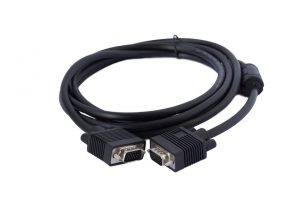
Video Graphics Array or VGA for short is a connector mainly used for linking the monitor or other display devices to the computer. The cable can be attached either to the computer motherboard or the graphics card itself. VGA was the graphics standard used by many devices in the past. From laptops and personal computers to projectors and television. The term is mainly used for the cable that transports the display signals. A standard VGA connector has 15 pins; 3 rows of 5 pins.
The use of a VGA cable can be traced back to the early IBM personal computers which first made an appearance in the late 1980s. VGA is limited in terms of video quality because it uses analog signals. Therefore, it is only capable of lower resolutions and displays quality. It can provide a max refresh rate of 60 Hz, 16 colors displayed at a time and a resolution of 640 x 480. However, 256 colors can be shown if the resolution is reduced to 320 x 200. The technology has been improved over time and now, a VGA connection can easily deliver full HD resolution.
Electromagnetic interference, as well as long cables, can lead to analog signal degradation. The loss of quality can be overcome by using shorter cables, the quality of the image may never reach the sharp image quality of an HDMI cable. The way that VGA works are by transmitting analog signals. The video signal received from the source is converted to analog which in turn will be transmitted via the cable. Older CRT monitors will accept the analog signal. When it comes to newer display devices, the analog signal is converted back to digital. The downside is that the back and forth conversion of the analog signal will result in image quality degradation.
To preserve the image quality, SVGA or super video graphic array cable were made. SVGA does a better job of keeping the analog signal intact by using thicker cables, better shielding and some have gold pins to enhance the conductivity between the ports. SVGA should only be used in the devices that need connecting are very far apart. However, if the devices are near each other, a VGA cable should do just fine in displaying a good quality image.
Over time the technology has been replaced by the Digital Visual Interface or DVI and the High Definition Multimedia Interface or HDMI for short. Today, VGA cables can still be found on some current devices, however, they are slowly starting to lose support in favor of HDMI technology. HDMI was developed as a better way of transmitting digital signals between devices.
There is still a debate of whether or not a cable carrying an analog signal could offer similar or better image quality as the cables that are carrying a digital signal. But since VGA cables are becoming more unused on newer devices, it can be seen as a clear answer that VGS cables will be replaced in total. This can be seen with graphics cards. Today’s motherboards are still manufactured with VGA connector in mind but when it comes to newer generation graphics cards, the VGA connector is non-existent.